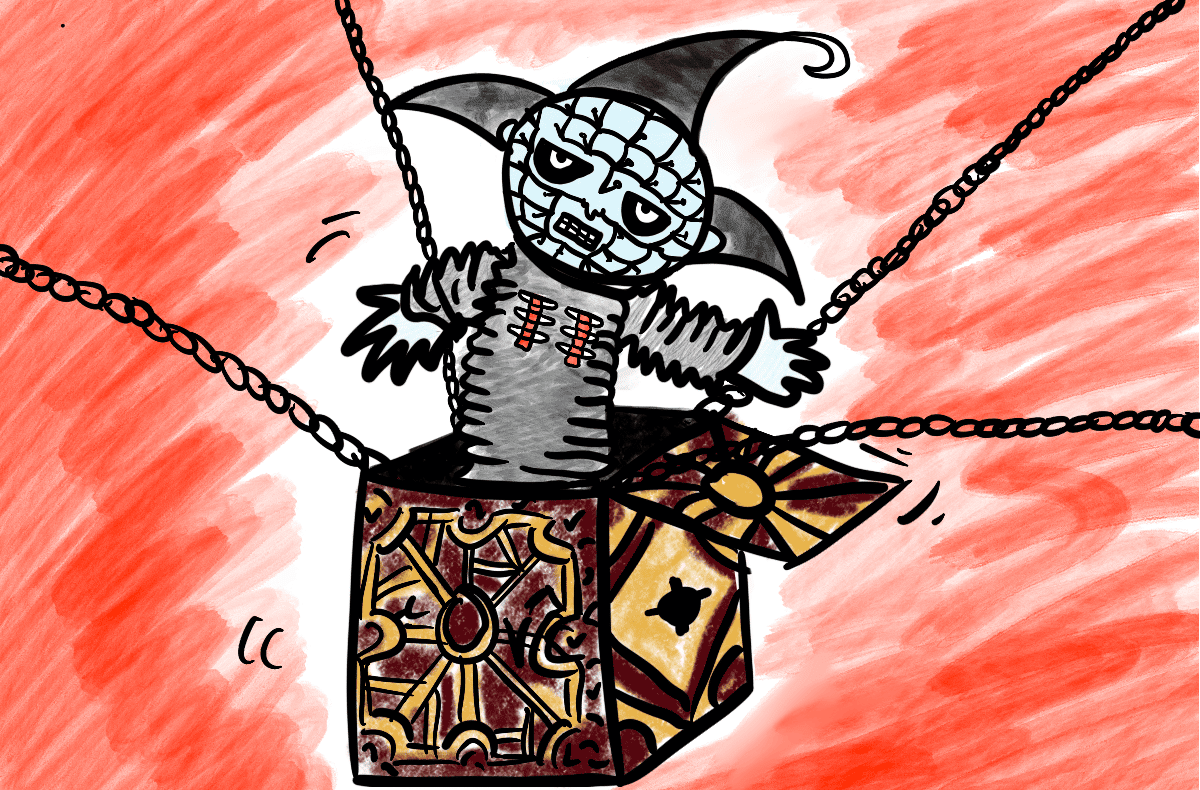
For Halloween, I found myself watching what I can only describe as a fuckton of Hellraiser films, since I thought offering a (not so) definitive guide would be a cool feature to put up on New Thinking in the spirit of the holiday. Lo and behold, watching eleven movies gives you a whole lot to write about, so for my article this week, I thought I’d do a little self-referential Marginalia—like two mirrors reflecting into an infinity of cinematic horror navel-gazing.
The article I wrote was a “beginner’s guide” to Hellraiser, which got a bit granular in breaking down which of the many films would be worth your while to watch. But beyond my feelings about each individual part of the whole, some “macro trends” emerged that didn’t really have a place to live in that article—things that, in my opinion, give the series its uniqueness and weird charm. So in Marginalia style, here’s some random observations about Hellraiser minutiae I thought I’d share:
- Everybody smokes. Whether it’s the embodiment-of-80s-style wife smoking indoors (and stubbing out her cigarette on the hardwood floor like a maniac) in the first Hellraiser, the guy wandering off the street with a freshly-lit cigarette to buy the creepy pillar containing Pinhead from an art gallery in the third, the edgy reporter lighting up in the crack den she’s infiltrated in the seventh, or a visiting neighbor randomly smoking a cigar in the ninth in a moment of crisis, there’s a weird amount of conspicuous smoking going on. Or maybe I’ve just been living in the future long enough that this amount of smoking now looks weird. But I do feel like it’s never been okay to randomly put out a cigarette on the floor of a residential home—or to light up in a gallery selling rare artifacts. Anyway. If you drank every time someone smoked tobacco in these films, you’d be trashed.
- There’s an enjoyable prominence of female protagonists. The original two Hellraiser films center on a teenaged Kirsty Cotton, who is one of the finest final girls you’ll see in an 80s horror flick. Instead of impotently screaming and feebly running in horror in the face of the creepy demon Cenobites, she keeps her shit together, trying her best to save her Dad—and other innocent souls she encounters in the convoluted sequel—and using her wits to escape an otherwise inescapable fate—something pretty much only she manages to do in the entire franchise. It was legitimately refreshing to see an 80s gore fest with a woman character that level of competent, and not over sexualized. The most recent reboot also had a competent female protagonist, which felt like a worthy nod to this tradition.
- There are boobs, but not as much as you might think. One of the main ideas behind the Hellraiser mythos is that, once you unlock this creepy puzzle box, otherworldly creatures called Cenobites show up to take you beyond the level of sensations your earthly flesh has known… so it attracts a lot of hedonists looking for the next thrill. That said, there’s a lot of bondage-y tits-out scenes to paint the picture, but all told, it really isn’t that gratuitous (until the tenth—but that’s one of several reasons that it was my second to least favorite of the eleven films.)
- It’s better at BDSM than Fifty Shades. Just a quick glance at the makeup design of the Cenobites and you’ll gather that there’s a strong sadomasochistic/bondage theme going on, with all kinds of vinyl mixed in with extreme piercings, flayed skin and the like. (Lots of skin being removed… so that’s a big trigger warning, there.) Naturally, they’re completely taking body mods to the extreme, and it’s a horror film, so it’s not trying to depict realistic sex play. That said, the roots are there: the film’s BDSM undertones are thought to derive from author Clive Barker’s own predilection for leather bars. It’s important to note that BDSM in the real world is all about respectful, consenting play that subverts traditional power dynamics—something tons of people pointed out Fifty Shades of Grey got completely wrong. Although still a flight of fancy, Hellraiser does offer a few valid BDSM-related takeaways—like the whole idea of pain and pleasure being inherently interconnected, and the idea that the Cenobites only show up for people who actually want them there. (Unfortunately, they are a terrible model for withdrawal of consent—so the moral here is: the true way to outwit and escape Pinhead and his crew would be to choose a robust safeword.)
- The series cringe-ily features three name actors (or 2.5, to be a bit less generous). It’s a Hollywood trope that every famous actor got their start in a slasher flick—Jennifer Aniston in Leprechaun, Kevin Bacon in Friday the 13th, or Johnny Depp in Nightmare on Elm Street, and so on. It’s always a trip to see people with respectable careers in some god-awful film during their youth. If that’s your thing, don’t miss a dewey-faced Adam Scott in Hellraiser IV: Bloodline, never-not-been-annoyingly-hot pre-Superman Henry Cavill in Hellraiser: Hellworld, or Dean Winter (a.k.a. “Mayhem” in the Allstate commercials) in Hellraiser: Hellseeker. (I don’t really know Dean Winter by name, but I do recognize him and he had a great arc on Law and Order: SVU—the man works.)
- Doug Bradley is a phenomenal actor. Watching Doug Bradley play Pinhead in eight different movies—with different directors, aesthetics, and screenplays—across nearly two decades was impressive, to say the least. Even with the most completely off-the-rails copy, the man was always 100% committed to his character. Seeing him bring his all to straight-to-video films gives me undying respect for him as an artist. It’s worth watching several of these just to see him work.
So that’s your quick version of the Hellraiser beginner’s guide: and you just saved yourself a Cinemax subscription. It’s November anyway—time to put our horror-binge watching away until next fall and queue up your video streaming services with the real cinematic works of horror: Hallmark Christmas movies. (I tremble.)



